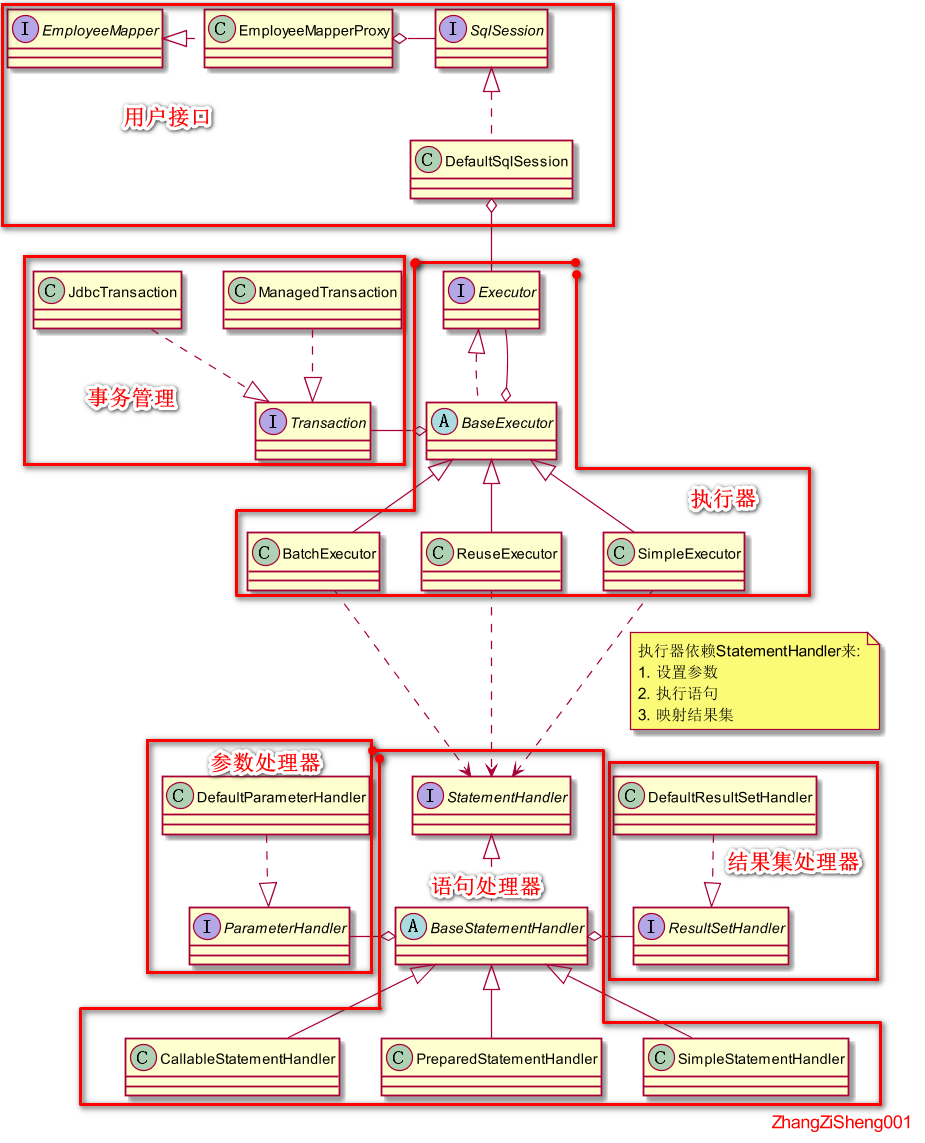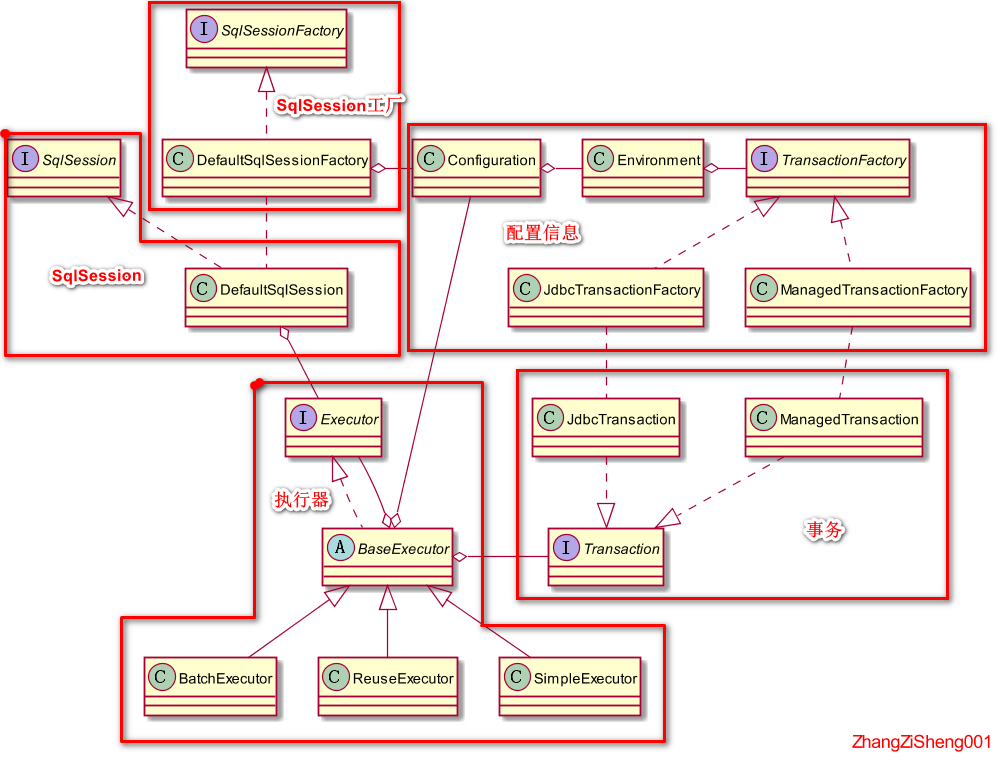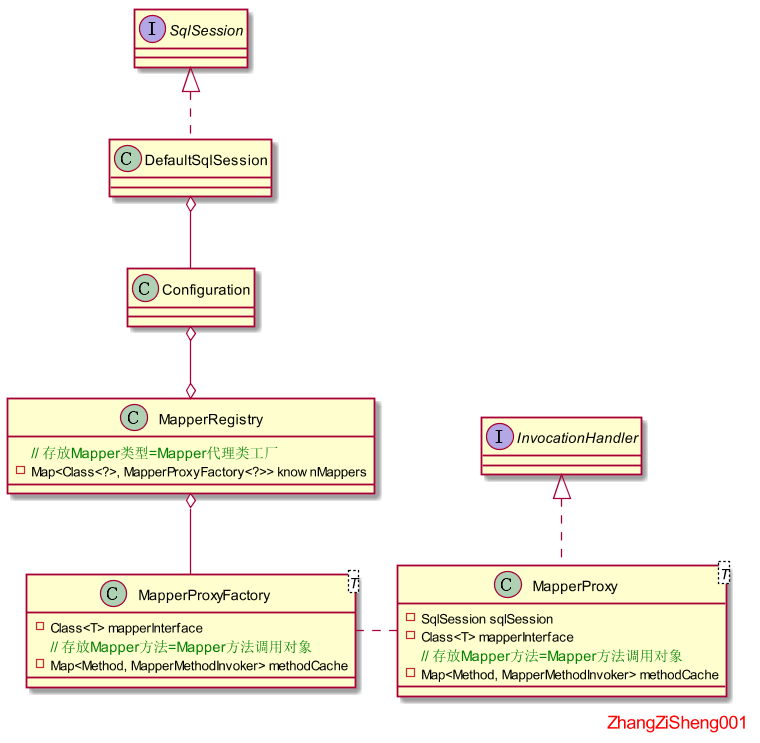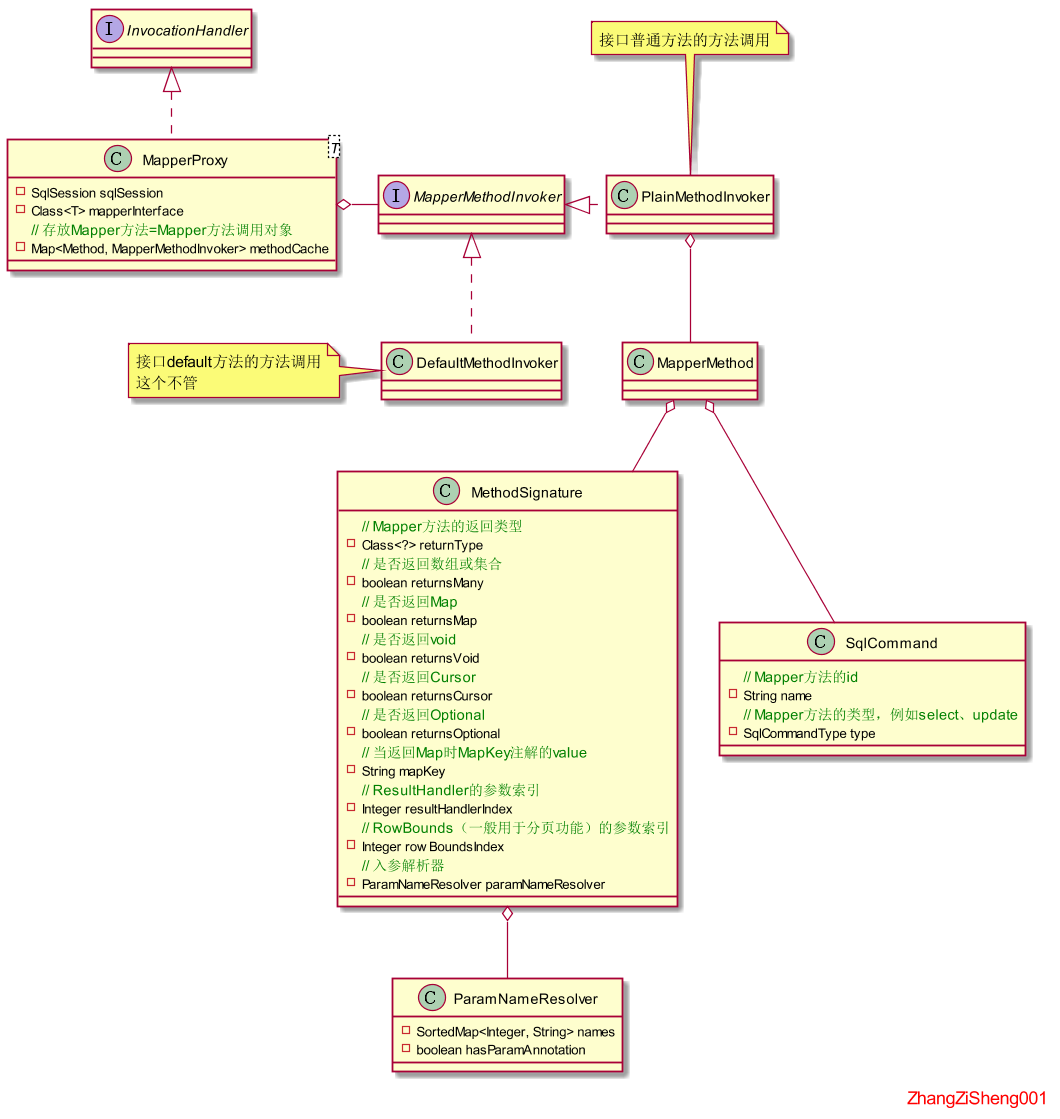Mybatis原始碼詳解系列(三)--從Mapper介面開始看Mybatis的執行邏輯
簡介
Mybatis 是一個持久層框架,它對 JDBC 進行了高階封裝,使我們的程式碼中不會出現任何的 JDBC 程式碼,另外,它還通過 xml 或註解的方式將 sql 從 DAO/Repository 層中解耦出來,除了這些基本功能外,它還提供了動態 sql、延遲載入、快取等功能。 相比 Hibernate,Mybatis 更面向資料庫,可以靈活地對 sql 語句進行優化。
本文繼續分析 Mybatis 的原始碼,第1點內容上一篇部落格已經講過,本文將針對 2 和 3 點繼續分析:
- 載入配置、初始化
SqlSessionFactory; - 獲取
SqlSession和Mapper; - 執行
Mapper方法。
除了原始碼分析,本系列還包含 Mybatis 的詳細使用方法、高階特性、生成器等,相關內容可以我的專欄 Mybatis 。
注意,考慮可讀性,文中部分原始碼經過刪減。
隱藏在Mapper背後的東西
從使用者的角度來看,專案中使用 Mybatis 時,我們只需要定義Mapper介面和編寫 xml,除此之外,不需要去使用 Mybatis 的其他東西。當我們呼叫了 Mapper 介面的方法,Mybatis 悄無聲息地為我們完成引數設定、語句執行、結果對映等等工作,這真的是相當優秀的設計。
既然是分析原始碼,就必須搞清楚隱藏 Mapper 介面背後都是什麼東西。這裡我畫了一張 UML 圖,通過這張圖,應該可以對 Mybatis 的架構及 Mapper 方法的執行過程形成比較巨集觀的瞭解。

針對上圖,我再簡單梳理下:
Mapper和SqlSession可以認為是使用者的入口(專案中也可以不用Mapper介面,直接使用SqlSession),Mybatis 為我們生產的Mapper實現類最終都會去呼叫SqlSession的方法;Executor作為整個執行流程的排程者,它依賴StatementHandler來完成引數設定、語句執行和結果對映,使用Transaction來管理事務。StatementHandler呼叫ParameterHandler為語句設定引數,呼叫ResultSetHandler將結果集對映為所需物件。
那麼,我們開始看原始碼吧。
Mapper代理類的獲取
一般情況下,我們會先拿到SqlSession物件,然後再利用SqlSession獲取Mapper物件,這部分的原始碼也是按這個順序開展。
// 獲取 SqlSession
SqlSession sqlSession = sqlSessionFactory.openSession();
// 獲取 Mapper
EmployeeMapper baseMapper = sqlSession.getMapper(EmployeeMapper.class);
先拿到SqlSession物件
SqlSession的獲取過程
上一篇部落格講了DefaultSqlSessionFactory的初始化,現在我們將利用DefaultSqlSessionFactory來建立SqlSession,這個過程也會創建出對應的Executor和Transaction,如下圖所示。

圖中的SqlSession建立時需要先建立Executor,而Executor又要依賴Transaction的建立,Transaction則需要依賴已經初始化好的TransactionFactory和DataSource。
進入到DefaultSqlSessionFactory.openSession()方法。預設情況下,SqlSession是執行緒不安全的,主要和Transaction物件有關,如果考慮複用SqlSession物件的話,需要重寫Transaction的實現。
@Override
public SqlSession openSession() {
// 預設會使用SimpltExecutors,以及autoCommit=false,事務隔離級別為空
// 當然我們也可以在入參指定
// 補充:SIMPLE 就是普通的執行器;REUSE 執行器會重用預處理語句(PreparedStatement);BATCH 執行器不僅重用語句還會執行批量更新。
return openSessionFromDataSource(configuration.getDefaultExecutorType(), null, false);
}
private SqlSession openSessionFromDataSource(ExecutorType execType, TransactionIsolationLevel level, boolean autoCommit) {
Transaction tx = null;
try {
// 獲取Environment中的TransactionFactory和DataSource,用來建立事務物件
final Environment environment = configuration.getEnvironment();
final TransactionFactory transactionFactory = getTransactionFactoryFromEnvironment(environment);
tx = transactionFactory.newTransaction(environment.getDataSource(), level, autoCommit);
// 建立執行器,這裡也會給執行器安裝外掛
final Executor executor = configuration.newExecutor(tx, execType);
// 建立DefaultSqlSession
return new DefaultSqlSession(configuration, executor, autoCommit);
} catch (Exception e) {
closeTransaction(tx); // may have fetched a connection so lets call close()
throw ExceptionFactory.wrapException("Error opening session. Cause: " + e, e);
} finally {
ErrorContext.instance().reset();
}
}
如何給執行器安裝外掛
上面的程式碼比較簡單,這裡重點說下安裝外掛的過程。我們進入到Configuration.newExecutor(Transaction, ExecutorType),可以看到建立完執行器後,還需要給執行器安裝外掛,接下來就是要分析下如何給執行器安裝外掛。
protected final InterceptorChain interceptorChain = new InterceptorChain();
public Executor newExecutor(Transaction transaction, ExecutorType executorType) {
executorType = executorType == null ? defaultExecutorType : executorType;
executorType = executorType == null ? ExecutorType.SIMPLE : executorType;
Executor executor;
// 根據executorType選擇建立不同的執行器
if (ExecutorType.BATCH == executorType) {
executor = new BatchExecutor(this, transaction);
} else if (ExecutorType.REUSE == executorType) {
executor = new ReuseExecutor(this, transaction);
} else {
executor = new SimpleExecutor(this, transaction);
}
if (cacheEnabled) {
executor = new CachingExecutor(executor);
}
// 安裝外掛
executor = (Executor) interceptorChain.pluginAll(executor);
return executor;
}
進入到InterceptorChain.pluginAll(Object)方法,這是一個相當通用的方法,不是隻能給Executor安裝外掛,後面我們看到的StatementHandler、ResultSetHandler、ParameterHandler等都會被安裝外掛。
private final List<Interceptor> interceptors = new ArrayList<>();
public Object pluginAll(Object target) {
// 遍歷安裝所有執行器
for (Interceptor interceptor : interceptors) {
target = interceptor.plugin(target);
}
return target;
}
// 進入到Interceptor.plugin(Object)方法,這個是接口裡的方法,使用 default 宣告
default Object plugin(Object target) {
return Plugin.wrap(target, this);
}
在定義外掛時,一般我們都會採用註解來指定需要攔截的介面及其方法,如下。安裝外掛的方法之所以能夠通用,主要還是@Signature註解的功勞,註解中,我們已經明確了攔截哪個介面的哪個方法。注意,這裡我也可以定義其他介面,例如StatementHandler。
@Intercepts(
{
@Signature(type = Executor.class, method = "query", args = {MappedStatement.class, Object.class, RowBounds.class, ResultHandler.class}),
@Signature(type = Executor.class, method = "query", args = {MappedStatement.class, Object.class, RowBounds.class, ResultHandler.class, CacheKey.class, BoundSql.class}),
}
)
public class PageInterceptor implements Interceptor {
@Override
public Object intercept(Invocation invocation) throws Throwable {
// do something
}
}
上面這個外掛將對Executor介面的以下兩個方法進行攔截:
<E> List<E> query(MappedStatement ms, Object parameter, RowBounds rowBounds, ResultHandler resultHandler, CacheKey cacheKey, BoundSql boundSql) throws SQLException;
<E> List<E> query(MappedStatement ms, Object parameter, RowBounds rowBounds, ResultHandler resultHandler) throws SQLException;
那麼,Mybatis 是如何實現的呢?我們進入到Plugin這個類,它是一個InvocationHandler,也就是說 Mybatis 使用的是 JDK 的動態代理來實現外掛功能,後面程式碼中, JDK 的動態代理也會經常出現。
public class Plugin implements InvocationHandler {
// 需要被安裝外掛的類
private final Object target;
// 需要安裝的外掛
private final Interceptor interceptor;
// 存放外掛攔截的介面接對應的方法
private final Map<Class<?>, Set<Method>> signatureMap;
private Plugin(Object target, Interceptor interceptor, Map<Class<?>, Set<Method>> signatureMap) {
this.target = target;
this.interceptor = interceptor;
this.signatureMap = signatureMap;
}
public static Object wrap(Object target, Interceptor interceptor) {
// 根據外掛的註解獲取外掛攔截哪些介面哪些方法
Map<Class<?>, Set<Method>> signatureMap = getSignatureMap(interceptor);
// 獲取目標類中需要被攔截的所有介面
Class<?> type = target.getClass();
Class<?>[] interfaces = getAllInterfaces(type, signatureMap);
if (interfaces.length > 0) {
// 建立代理類
return Proxy.newProxyInstance(
type.getClassLoader(),
interfaces,
new Plugin(target, interceptor, signatureMap));
}
return target;
}
@Override
public Object invoke(Object proxy, Method method, Object[] args) throws Throwable {
try {
// 以“當前方法的宣告類”為key,查詢需要被外掛攔截的方法
Set<Method> methods = signatureMap.get(method.getDeclaringClass());
// 如果包含當前方法,那麼會執行外掛裡的intercept方法
if (methods != null && methods.contains(method)) {
return interceptor.intercept(new Invocation(target, method, args));
}
// 如果並不包含當前方法,則直接執行該方法
return method.invoke(target, args);
} catch (Exception e) {
throw ExceptionUtil.unwrapThrowable(e);
}
}
以上就是獲取SqlSession和安裝外掛的內容。預設情況下,SqlSession是執行緒不安全的,不斷地建立SqlSession也不是很明智的做法,按道理,Mybatis 應該提供執行緒安全的一套SqlSession實現才對。
再獲取Mapper代理類
Mapper 代理類的獲取過程比較簡單,這裡我們就不一步步看原始碼了,直接看圖就行。我畫了 UML 圖,通過這個圖基本可以梳理以下幾個類的關係,繼而明白獲取 Mapper 代理類的方法呼叫過程,另外,我們也能知道,Mapper 代理類也是使用 JDK 的動態代理生成。

Mapper 作為一個使用者介面,最終還是得呼叫SqlSession來進行增刪改查,所以,代理類也必須持有對SqlSession的引用。通常情況下,這樣的 Mapper代理類是執行緒不安全的,因為它持有的SqlSession實現類DefaultSqlSession也是執行緒不安全的,但是,如果實現類是SqlSessionManager就另當別論了。
Mapper方法的執行
執行Mapper代理方法
因為Mapper代理類是通過 JDK 的動態代理生成,當呼叫Mapper代理類的方法時,對應的InvocationHandler物件(即MapperProxy)將被呼叫,所以,這裡就不展示Mapper代理類的程式碼了,直接從MapperProxy這個類開始分析。
同樣地,還是先看看整個 UML 圖,通過圖示大致可以梳理出方法的呼叫過程。MethodSignature這個類可以重點看下,它的屬性非常關鍵。

下面開始看原始碼,進入到MapperProxy.invoke(Object, Method, Object[])。這裡的MapperMethodInvoker物件會被快取起來,因為這個類是無狀態的,不需要反覆的建立。當快取中沒有對應的MapperMethodInvoker時,方法對應的MapperMethodInvoker實現類將被建立並放入快取,同時MapperMethod、MethodSignature、sqlCommand等物件都會被建立好。
@Override
public Object invoke(Object proxy, Method method, Object[] args) throws Throwable {
try {
// 如果是Object類宣告的方法,直接呼叫
if (Object.class.equals(method.getDeclaringClass())) {
return method.invoke(this, args);
} else {
// 先從快取拿到MapperMethodInvoker物件,再呼叫它的方法
// 因為最終會呼叫SqlSession的方法,所以這裡得傳入SqlSession物件
return cachedInvoker(method).invoke(proxy, method, args, sqlSession);
}
} catch (Throwable t) {
throw ExceptionUtil.unwrapThrowable(t);
}
}
private MapperMethodInvoker cachedInvoker(Method method) throws Throwable {
try {
// 快取有就拿,沒有需建立並放入快取
return methodCache.computeIfAbsent(method, m -> {
// 如果是介面中定義的default方法,建立MapperMethodInvoker實現類DefaultMethodInvoker
// 這種情況我們不關注
if (m.isDefault()) {
try {
if (privateLookupInMethod == null) {
return new DefaultMethodInvoker(getMethodHandleJava8(method));
} else {
return new DefaultMethodInvoker(getMethodHandleJava9(method));
}
} catch (IllegalAccessException | InstantiationException | InvocationTargetException
| NoSuchMethodException e) {
throw new RuntimeException(e);
}
} else {
// 如果不是介面中定義的default方法,建立MapperMethodInvoker實現類PlainMethodInvoker,在此之前也會建立MapperMethod
return new PlainMethodInvoker(new MapperMethod(mapperInterface, method, sqlSession.getConfiguration()));
}
});
} catch (RuntimeException re) {
Throwable cause = re.getCause();
throw cause == null ? re : cause;
}
}
由於我們不考慮DefaultMethodInvoker的情況,所以,這裡直接進入到MapperProxy.PlainMethodInvoker.invoke(Object, Method, Object[], SqlSession)。
private final MapperMethod mapperMethod;
@Override
public Object invoke(Object proxy, Method method, Object[] args, SqlSession sqlSession) throws Throwable {
// 直接呼叫MapperMethod的方法,method和proxy的入參丟棄
return mapperMethod.execute(sqlSession, args);
}
進入到MapperMethod.execute(SqlSession, Object[])方法。前面提到過 Mapper 代理類必須依賴SqlSession物件來進行增刪改查,在這個方法就可以看到,方法中會通過方法的型別來決定呼叫SqlSession的哪個方法。
在進行引數轉換時有三種情況:
-
如果引數為空,則 param 為 null;
-
如果引數只有一個且不包含
Param註解,則 param 就是該入參物件; -
如果引數大於一個或包含了
Param註解,則 param 是一個Map<String, Object>,key 為註解Param的值,value 為對應入參物件。
另外,針對 insert|update|delete 方法,Mybatis 支援使用 void、Integer/int、Long/long、Boolean/boolean 的返回型別,而針對 select 方法,支援使用 Collection、Array、void、Map、Cursor、Optional 返回型別,並且支援入參 RowBounds 來進行分頁,以及入參 ResultHandler 來處理返回結果。
public Object execute(SqlSession sqlSession, Object[] args) {
Object result;
// 判斷屬於哪種型別,來決定呼叫SqlSession的哪個方法
switch (command.getType()) {
// 如果為insert型別方法
case INSERT: {
// 引數轉換
Object param = method.convertArgsToSqlCommandParam(args);
// rowCountResult將根據返回型別來處理result,例如,當返回型別為boolean時影響的rowCount是否大於0,當返回型別為int時,直接返回rowCount
result = rowCountResult(sqlSession.insert(command.getName(), param));
break;
}
// 如果為update型別方法
case UPDATE: {
Object param = method.convertArgsToSqlCommandParam(args);
result = rowCountResult(sqlSession.update(command.getName(), param));
break;
}
// 如果為delete型別方法
case DELETE: {
Object param = method.convertArgsToSqlCommandParam(args);
result = rowCountResult(sqlSession.delete(command.getName(), param));
break;
}
// 如果為select型別方法
case SELECT:
// 返回void,且入參有ResultHandler
if (method.returnsVoid() && method.hasResultHandler()) {
executeWithResultHandler(sqlSession, args);
result = null;
// 返回型別為陣列或List
} else if (method.returnsMany()) {
result = executeForMany(sqlSession, args);
// 返回型別為Map
} else if (method.returnsMap()) {
result = executeForMap(sqlSession, args);
// 返回型別為Cursor
} else if (method.returnsCursor()) {
result = executeForCursor(sqlSession, args);
// 這種一般是返回單個實體物件或者Optional物件
} else {
Object param = method.convertArgsToSqlCommandParam(args);
result = sqlSession.selectOne(command.getName(), param);
if (method.returnsOptional()
&& (result == null || !method.getReturnType().equals(result.getClass()))) {
result = Optional.ofNullable(result);
}
}
break;
// 如果為FLUSH型別方法,這種情況不關注
case FLUSH:
result = sqlSession.flushStatements();
break;
default:
throw new BindingException("Unknown execution method for: " + command.getName());
}
// 當方法返回型別為基本型別,但是result卻為空,這種情況會丟擲異常
if (result == null && method.getReturnType().isPrimitive() && !method.returnsVoid()) {
throw new BindingException("Mapper method '" + command.getName()
+ " attempted to return null from a method with a primitive return type (" + method.getReturnType() + ").");
}
return result;
}
增刪改的我們不繼續看了,至於查的,只看method.returnsMany()的情況。進入到MapperMethod.executeForMany(SqlSession, Object[])。通過這個方法可以知道,當返回多個物件時,Mapper 中我們可以使用List接收,也可以使用陣列或者Collection的其他子類來接收,但是處於效能考慮,如果不是必須,建議還是使用List比較好。
將RowBounds作為 Mapper 方法的入參,可以支援自動分頁功能,但是,這種方式存在一個很大缺點,就是 Mybatis 會將所有結果查放入本地記憶體再進行分頁,而不是查的時候嵌入分頁引數。所以,這個分頁入參,建議還是不要使用了。
private <E> Object executeForMany(SqlSession sqlSession, Object[] args) {
List<E> result;
// 轉換引數
Object param = method.convertArgsToSqlCommandParam(args);
// 如果入參包含RowBounds物件,這個一般用於分頁使用
if (method.hasRowBounds()) {
RowBounds rowBounds = method.extractRowBounds(args);
result = sqlSession.selectList(command.getName(), param, rowBounds);
} else {
// 不用分頁的情況
result = sqlSession.selectList(command.getName(), param);
}
// 如果SqlSession方法的返回型別和Mapper方法的返回型別不一致
// 例如,mapper返回型別為陣列、Collection的其他子類
if (!method.getReturnType().isAssignableFrom(result.getClass())) {
// 如果mapper方法要求返回陣列
if (method.getReturnType().isArray()) {
return convertToArray(result);
} else {
// 如果要求返回Set等Collection子類,這個方法感興趣的可以研究下,非常值得借鑑學習
return convertToDeclaredCollection(sqlSession.getConfiguration(), result);
}
}
return result;
}
從Mapper進入到SqlSession
接下來就需要進入SqlSession的方法了,這裡選用實現類DefaultSqlSession進行分析。SqlSession作為使用者入口,程式碼不會太多,主要工作還是通過執行器來完成。
在呼叫執行器方法之前,這裡會對引數物件再次包裝,一般針對入參只有一個引數且不包含Param註解的情況:
- 如果是
Collection子類,將轉換為放入"collection"=object鍵值對的 map,如果它是List的子類,還會再放入"list"=object的鍵值對 - 如果是陣列,將轉換為放入
"array"=object鍵值對的 map
@Override
public <E> List<E> selectList(String statement, Object parameter) {
// 這裡還是給它傳入了一個分頁物件,這個物件預設分頁引數為0,Integer.MAX_VALUE
return this.selectList(statement, parameter, RowBounds.DEFAULT);
}
@Override
public <E> List<E> selectList(String statement, Object parameter, RowBounds rowBounds) {
try {
// 利用方法id從配置物件中拿到MappedStatement物件
MappedStatement ms = configuration.getMappedStatement(statement);
// 接著執行器開始排程,傳入resultHandler為空
return executor.query(ms, wrapCollection(parameter), rowBounds, Executor.NO_RESULT_HANDLER);
} catch (Exception e) {
throw ExceptionFactory.wrapException("Error querying database. Cause: " + e, e);
} finally {
ErrorContext.instance().reset();
}
}
執行器開始排程
接下來就進入執行器的部分了。注意,由於本文不會涉及到 Mybatis 結果快取的內容,所以,下面的程式碼都會刪除快取相關的部分。
那麼,還是回到最開始的圖,接下來將選擇SimpleExecutor進行分析。

進入到BaseExecutor.query(MappedStatement, Object, RowBounds, ResultHandler)。這個方法中會根據入參將動態語句轉換為靜態語句,並生成對應的ParameterMapping。
例如,
<if test="con.gender != null">and e.gender = {con.gender}</if>
將被轉換為 and e.gender = ?,並且生成
ParameterMapping{property='con.gender', mode=IN, javaType=class java.lang.Object, jdbcType=null, numericScale=null, resultMapId='null', jdbcTypeName='null', expression='null'}
的ParameterMapping。
生成的ParameterMapping將根據?的索引放入集合中待使用。
這部分內容我就不展開了,感興趣地可以自行研究。
@Override
public <E> List<E> query(MappedStatement ms, Object parameter, RowBounds rowBounds, ResultHandler resultHandler) throws SQLException {
// 將sql語句片段中的動態部分轉換為靜態,並生成對應的ParameterMapping
BoundSql boundSql = ms.getBoundSql(parameter);
// 生成快取的key
CacheKey key = createCacheKey(ms, parameter, rowBounds, boundSql);
return query(ms, parameter, rowBounds, resultHandler, key, boundSql);
}
接下來一大堆關於結果快取的程式碼,前面說過,本文不講,所以我們直接跳過進入到SimpleExecutor.doQuery(MappedStatement, Object, RowBounds, ResultHandler, BoundSql)。可以看到,接下來的任務都是由StatementHandler來完成,包括了引數設定、語句執行和結果集對映等。
@Override
public <E> List<E> doQuery(MappedStatement ms, Object parameter, RowBounds rowBounds, ResultHandler resultHandler, BoundSql boundSql) throws SQLException {
Statement stmt = null;
try {
Configuration configuration = ms.getConfiguration();
// 獲取StatementHandler物件,在上面的UML中可以看到,它非常重要
// 建立StatementHandler物件時,會根據StatementType自行判斷選擇SimpleStatementHandler、PreparedStatementHandler還是CallableStatementHandler實現類
// 另外,還會給它安裝執行器的所有外掛
StatementHandler handler = configuration.newStatementHandler(wrapper, ms, parameter, rowBounds, resultHandler, boundSql);
// 獲取Statement物件,並設定引數
stmt = prepareStatement(handler, ms.getStatementLog());
// 執行語句,並對映結果集
return handler.query(stmt, resultHandler);
} finally {
closeStatement(stmt);
}
}
本文將對以下兩行程式碼分別展開分析。其中,關於引數設定的內容不會細講,更多地精力會放在結果集對映上面。
// 獲取Statement物件,並設定引數
stmt = prepareStatement(handler, ms.getStatementLog());
// 執行語句,並對映結果集
return handler.query(stmt, resultHandler);
語句處理器開始處理語句
在建立StatementHandler時,會通過MappedStatement.getStatementType()自動選擇使用哪種語句處理器,有以下情況:
- 如果是 STATEMENT,則選擇
SimpleStatementHandler; - 如果是 PREPARED,則選擇
PreparedStatementHandler; - 如果是 CALLABLE,則選擇
CallableStatementHandler; - 其他情況丟擲異常。
本文將選用PreparedStatementHandler進行分析。
獲取語句物件和設定引數
進入到SimpleExecutor.prepareStatement(StatementHandler, Log)。這個方法將會獲取當前語句的PreparedStatement物件,並給它設定引數。
protected Transaction transaction;
private Statement prepareStatement(StatementHandler handler, Log statementLog) throws SQLException {
Statement stmt;
// 獲取連線物件,通過Transaction獲取
Connection connection = getConnection(statementLog);
// 獲取Statement物件,由於分析的是PreparedStatementHandler,所以會返回實現類PreparedStatement
stmt = handler.prepare(connection, transaction.getTimeout());
// 設定引數
handler.parameterize(stmt);
return stmt;
}
進入到PreparedStatementHandler.parameterize(Statement)。正如 UML 圖中說到的,這裡實際上是呼叫ParameterHandler來設定引數。
protected final ParameterHandler parameterHandler;
@Override
public void parameterize(Statement statement) throws SQLException {
parameterHandler.setParameters((PreparedStatement) statement);
}
進入到DefaultParameterHandler.setParameters(PreparedStatement)。前面講過,在將動態語句轉出靜態語句時,生成了語句每個?對應的ParameterMapping,並且這些ParameterMapping會按照語句中對應的索引被放入集合中。在以下方法中,就是遍歷這個集合,將引數設定到PreparedStatement中去。
private final TypeHandlerRegistry typeHandlerRegistry;
private final MappedStatement mappedStatement;
private final Object parameterObject;
private final BoundSql boundSql;
private final Configuration configuration;
@Override
public void setParameters(PreparedStatement ps) {
// 獲得當前語句對應的ParameterMapping
List<ParameterMapping> parameterMappings = boundSql.getParameterMappings();
if (parameterMappings != null) {
// 遍歷ParameterMapping
for (int i = 0; i < parameterMappings.size(); i++) {
ParameterMapping parameterMapping = parameterMappings.get(i);
// 一般情況mode都是IN,至於OUT的情況,用於結果對映到入參,比較少用
if (parameterMapping.getMode() != ParameterMode.OUT) {
Object value;// 用於設定到ps中的?的引數
// 這個propertyName對應mapper中#{value}的名字
String propertyName = parameterMapping.getProperty();
// 判斷additionalParameters是否有這個propertyName,這種情況暫時不清楚
if (boundSql.hasAdditionalParameter(propertyName)) { // issue #448 ask first for additional params
value = boundSql.getAdditionalParameter(propertyName);
// 如果入參為空
} else if (parameterObject == null) {
value = null;
// 如果有當前入參的型別處理器
} else if (typeHandlerRegistry.hasTypeHandler(parameterObject.getClass())) {
value = parameterObject;
// 如果沒有當前入參的型別處理器,這種一般是傳入實體物件或傳入Map的情況
} else {
// 這個原理和前面說過的MetaClass差不多
MetaObject metaObject = configuration.newMetaObject(parameterObject);
value = metaObject.getValue(propertyName);
}
TypeHandler typeHandler = parameterMapping.getTypeHandler();
JdbcType jdbcType = parameterMapping.getJdbcType();
// 如果未指定jdbcType,且入參為空,沒有在setting中配置jdbcTypeForNull的話,預設為OTHER
if (value == null && jdbcType == null) {
jdbcType = configuration.getJdbcTypeForNull();
}
try {
// 利用型別處理器給ps設定引數
typeHandler.setParameter(ps, i + 1, value, jdbcType);
} catch (TypeException | SQLException e) {
throw new TypeException("Could not set parameters for mapping: " + parameterMapping + ". Cause: " + e, e);
}
}
}
}
}
使用ParameterHandler設定引數的內容就不再多講,接下來分析語句執行和結果集對映的程式碼。
語句執行和結果集對映
進入到PreparedStatementHandler.query(Statement, ResultHandler)方法。語句執行就是普通的 JDBC,沒必要多講,重點看看如何使用ResultSetHandler完成結果集的對映。
protected final ResultSetHandler resultSetHandler;
@Override
public <E> List<E> query(Statement statement, ResultHandler resultHandler) throws SQLException {
PreparedStatement ps = (PreparedStatement) statement;
// 直接執行
ps.execute();
// 對映結果集
return resultSetHandler.handleResultSets(ps);
}
為了滿足多種需求,Mybatis 在處理結果集對映的邏輯非常複雜,這裡先簡單說下。
一般我們的 resultMap 是這樣配置的:
<resultMap id="blogResult" type="Blog">
<association property="author" column="author_id" javaType="Author" select="selectAuthor"/>
</resultMap>
<select id="selectBlog" resultMap="blogResult">
SELECT * FROM BLOG WHERE ID = #{id}
</select>
然而,Mybatis 竟然也支援多 resultSet 對映的情況,這裡拿到的第二個結果集將使用resultSet="authors"的resultMap 進行對映,並將得到的Author設定進Blog的屬性。
<resultMap id="blogResult" type="Blog">
<id property="id" column="id" />
<result property="title" column="title"/>
<association property="author" javaType="Author" resultSet="authors" column="author_id" foreignColumn="id">
<id property="id" column="id"/>
<result property="username" column="username"/>
<result property="password" column="password"/>
<result property="email" column="email"/>
<result property="bio" column="bio"/>
</association>
</resultMap>
<select id="selectBlog" resultSets="blogs,authors" resultMap="blogResult" statementType="CALLABLE">
{call getBlogsAndAuthors(#{id,jdbcType=INTEGER,mode=IN})}
</select>
還有一種更加奇葩的,多 resultSet、多 resultMap,如下。這種我暫時也不清楚怎麼用。
<select id="selectBlogs" resultSets="blogs01,blogs02" resultMap="blogResult01,blogResult02">
{call getTwoBlogs(#{id,jdbcType=INTEGER,mode=IN})}
</select>
接下來只考慮第一種情況。另外兩種感興趣的自己研究吧。
進入到DefaultResultSetHandler.handleResultSets(Statement)方法。
@Override
public List<Object> handleResultSets(Statement stmt) throws SQLException {
// 用於存放最終物件的集合
final List<Object> multipleResults = new ArrayList<>();
// resultSet索引
int resultSetCount = 0;
// 獲取第一個結果集
ResultSetWrapper rsw = getFirstResultSet(stmt);
// 獲取當前語句對應的所有ResultMap
List<ResultMap> resultMaps = mappedStatement.getResultMaps();
// resultMap總數
int resultMapCount = resultMaps.size();
// 校驗結果集非空時resultMapCount是否為空
validateResultMapsCount(rsw, resultMapCount);
// 接下來結果集和resultMap會根據索引一對一地對映
while (rsw != null && resultMapCount > resultSetCount) {
// 獲取與當前結果集對映的resultMap
ResultMap resultMap = resultMaps.get(resultSetCount);
// 對映結果集,並將生成的物件放入multipleResults
handleResultSet(rsw, resultMap, multipleResults, null);
// 獲取下一個結果集
rsw = getNextResultSet(stmt);
// TODO
cleanUpAfterHandlingResultSet();
// resultSet索引+1
resultSetCount++;
}
// 如果當前resultSet的索引小於resultSets中配置的resultSet數量,將繼續對映
// 這就是前面說的第二種情況了,這個不講
String[] resultSets = mappedStatement.getResultSets();
if (resultSets != null) {
while (rsw != null && resultSetCount < resultSets.length) {
// 獲取指定resultSet對應的ResultMap
ResultMapping parentMapping = nextResultMaps.get(resultSets[resultSetCount]);
if (parentMapping != null) {
// 獲取巢狀ResultMap進行對映
String nestedResultMapId = parentMapping.getNestedResultMapId();
ResultMap resultMap = configuration.getResultMap(nestedResultMapId);
handleResultSet(rsw, resultMap, null, parentMapping);
}
// 獲取下一個結果集
rsw = getNextResultSet(stmt);
// TODO
cleanUpAfterHandlingResultSet();
// resultSet索引+1
resultSetCount++;
}
}
// 如果multipleResults只有一個,返回multipleResults.get(0),否則整個multipleResults一起返回
return collapseSingleResultList(multipleResults);
}
進入DefaultResultSetHandler.handleResultSet(ResultSetWrapper, ResultMap, List<Object>, ResultMapping)。這裡的入參 parentMapping 一般為空,除非在語句中設定了多個 resultSet;
屬性 resultHandler 一般為空,除非在 Mapper 方法的入參中傳入,這個物件可以由使用者自己實現,通過它我們可以對結果進行操作。在實際專案中,我們往往是拿到實體物件後才到 Web 層完成 VO 物件的轉換,通過ResultHandler ,我們在 DAO 層就能完成 VO 物件的轉換,相比傳統方式,這裡可以減少一次集合遍歷,而且,因為可以直接傳入ResultHandler ,而不是具體實現,所以轉換過程不會滲透到 DAO層。注意,採用這種方式時,Mapper 的返回型別必須為 void。
private void handleResultSet(ResultSetWrapper rsw, ResultMap resultMap, List<Object> multipleResults, ResultMapping parentMapping) throws SQLException {
try {
// 如果不是設定了多個resultSets,parentMapping一般為空
// 所以,這種情況不關注
if (parentMapping != null) {
// 對映結果集
handleRowValues(rsw, resultMap, null, RowBounds.DEFAULT, parentMapping);
} else {
// resultHandler一般為空
if (resultHandler == null) {
// 建立defaultResultHandler
DefaultResultHandler defaultResultHandler = new DefaultResultHandler(objectFactory);
// 對映結果集
handleRowValues(rsw, resultMap, defaultResultHandler, rowBounds, null);
// 將物件放入集合
multipleResults.add(defaultResultHandler.getResultList());
} else {
// 對映結果集,如果傳入了自定義的ResultHandler,則由使用者自己處理對映好的物件
handleRowValues(rsw, resultMap, resultHandler, rowBounds, null);
}
}
} finally {
// issue #228 (close resultsets)
closeResultSet(rsw.getResultSet());
}
}
進入到DefaultResultSetHandler.handleRowValues(ResultSetWrapper, ResultMap, ResultHandler<?>, RowBounds, ResultMapping)。這裡會根據是否包含巢狀結果對映來判斷呼叫哪個方法,如果是巢狀結果對映,需要判斷是否允許分頁,以及是否允許使用自定義ResultHandler。
public void handleRowValues(ResultSetWrapper rsw, ResultMap resultMap, ResultHandler<?> resultHandler, RowBounds rowBounds, ResultMapping parentMapping) throws SQLException {
// 如果resultMap存在巢狀結果對映
if (resultMap.hasNestedResultMaps()) {
// 如果設定了safeRowBoundsEnabled=true,需校驗在巢狀語句中使用分頁時丟擲異常
ensureNoRowBounds();
// 如果設定了safeResultHandlerEnabled=false,需校驗在巢狀語句中使用自定義結果處理器時丟擲異常
checkResultHandler();
// 對映結果集
handleRowValuesForNestedResultMap(rsw, resultMap, resultHandler, rowBounds, parentMapping);
// 如果resultMap不存在巢狀結果對映
} else {
// 對映結果集
handleRowValuesForSimpleResultMap(rsw, resultMap, resultHandler, rowBounds, parentMapping);
}
}
這裡我就不搞那麼複雜了,就只看非巢狀結果的情況。進入DefaultResultSetHandler.handleRowValuesForSimpleResultMap(ResultSetWrapper, ResultMap, ResultHandler<?>, RowBounds, ResultMapping)。在這個方法中可以看到,使用RowBounds進行分頁時,Mybatis 會查出所有資料到記憶體中,然後再分頁,所以,不建議使用。
private void handleRowValuesForSimpleResultMap(ResultSetWrapper rsw, ResultMap resultMap, ResultHandler<?> resultHandler, RowBounds rowBounds, ResultMapping parentMapping)
throws SQLException {
// 建立DefaultResultContext物件,這個用來做標誌判斷使用,還可以作為ResultHandler處理結果的入參
DefaultResultContext<Object> resultContext = new DefaultResultContext<>();
// 獲取當前結果集
ResultSet resultSet = rsw.getResultSet();
// 剔除分頁offset以下資料
skipRows(resultSet, rowBounds);
while (shouldProcessMoreRows(resultContext, rowBounds) && !resultSet.isClosed() && resultSet.next()) {
// 如果存在discriminator,則根據結果集選擇匹配的resultMap,否則直接返回當前resultMap
ResultMap discriminatedResultMap = resolveDiscriminatedResultMap(resultSet, resultMap, null);
// 建立實體物件,並完成結果對映
Object rowValue = getRowValue(rsw, discriminatedResultMap, null);
// 一般會回撥ResultHandler的handleResult方法,讓使用者可以對對映好的結果進行處理
// 如果配置了resultSets的話,且當前在對映子結果集,那麼會將子結果集對映到的物件設定到父物件的屬性中
storeObject(resultHandler, resultContext, rowValue, parentMapping, resultSet);
}
}
進入DefaultResultSetHandler.getRowValue(ResultSetWrapper, ResultMap, String)方法。這個方法將建立物件,並完成結果集的對映。點到為止,有空再做補充了。
private Object getRowValue(ResultSetWrapper rsw, ResultMap resultMap, String columnPrefix) throws SQLException {
final ResultLoaderMap lazyLoader = new ResultLoaderMap();
// 建立實體物件,這裡會完成構造方法中引數的對映,以及完成懶載入的代理
Object rowValue = createResultObject(rsw, resultMap, lazyLoader, columnPrefix);
if (rowValue != null && !hasTypeHandlerForResultObject(rsw, resultMap.getType())) {
// MetaObject可以方便完成實體物件的獲取和設定屬性
final MetaObject metaObject = configuration.newMetaObject(rowValue);
// foundValues用於標識當前物件是否還有未對映完的屬性
boolean foundValues = this.useConstructorMappings;
// 對映列名和屬性名一致的屬性,如果設定了駝峰規則,那麼這部分也會對映
if (shouldApplyAutomaticMappings(resultMap, false)) {
foundValues = applyAutomaticMappings(rsw, resultMap, metaObject, columnPrefix) || foundValues;
}
// 對映property的RsultMapping
foundValues = applyPropertyMappings(rsw, resultMap, metaObject, lazyLoader, columnPrefix) || foundValues;
foundValues = lazyLoader.size() > 0 || foundValues;
// 返回對映好的物件
rowValue = foundValues || configuration.isReturnInstanceForEmptyRow() ? rowValue : null;
}
return rowValue;
}
以上,基本講完 Mapper 的獲取及方法執行相關原始碼的分析。
通過分析 Mybatis 的原始碼,希望讀者能夠更瞭解 Mybatis,從而在實際工作和學習中更好地使用,以及避免“被坑”。針對結果快取、引數設定以及其他細節問題,本文沒有繼續展開,後續有空再補充吧。
參考資料
Mybatis官方中文文件
相關原始碼請移步:mybatis-demo
本文為原創文章,轉載請附上原文出處連結:https://www.cnblogs.com/ZhangZiSheng001/p/12761376.html
